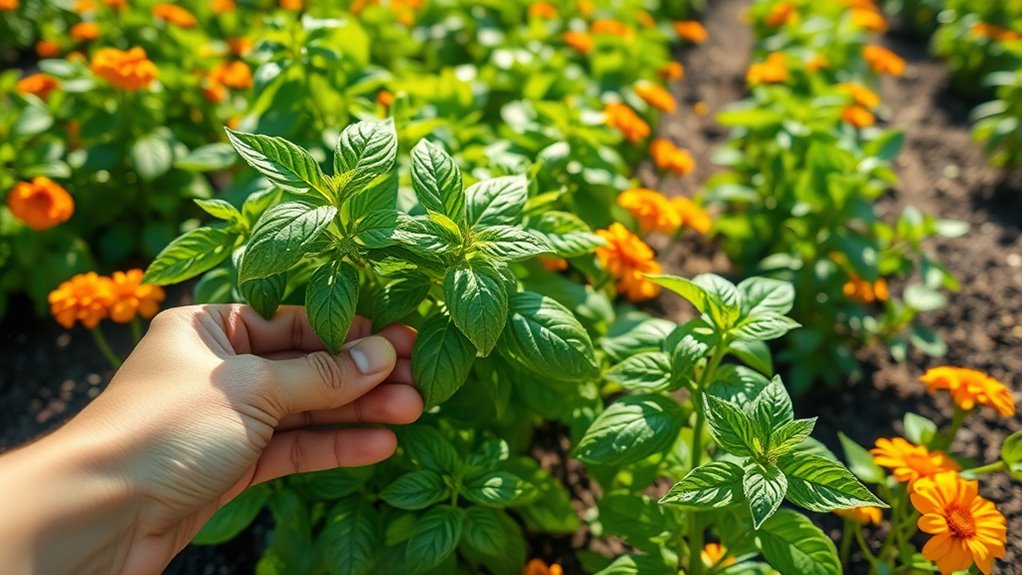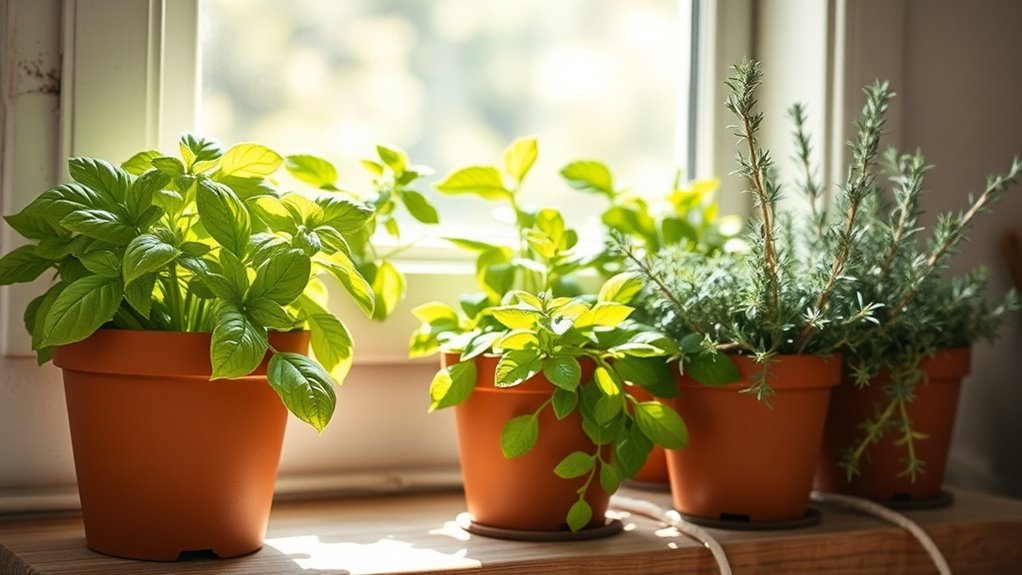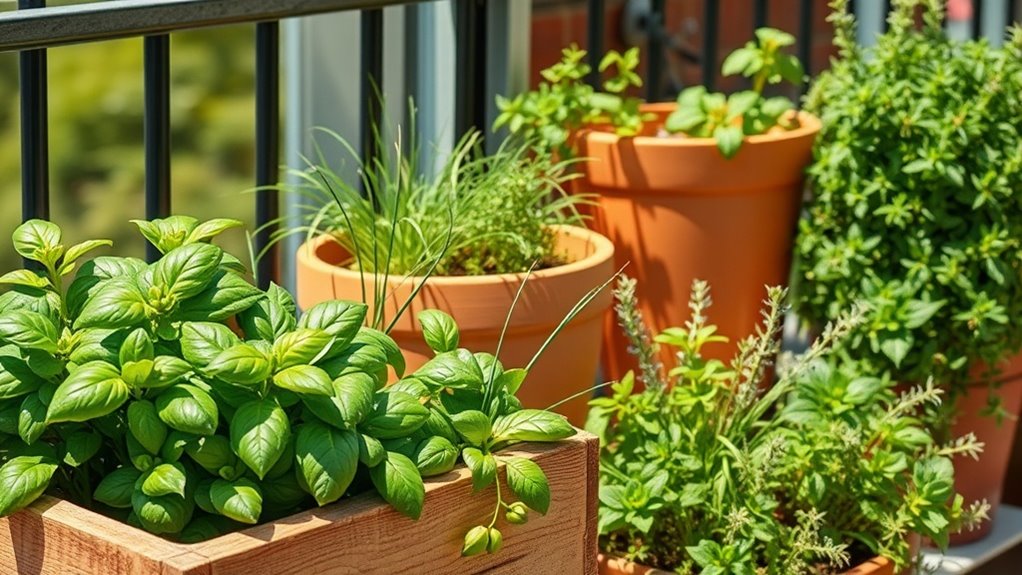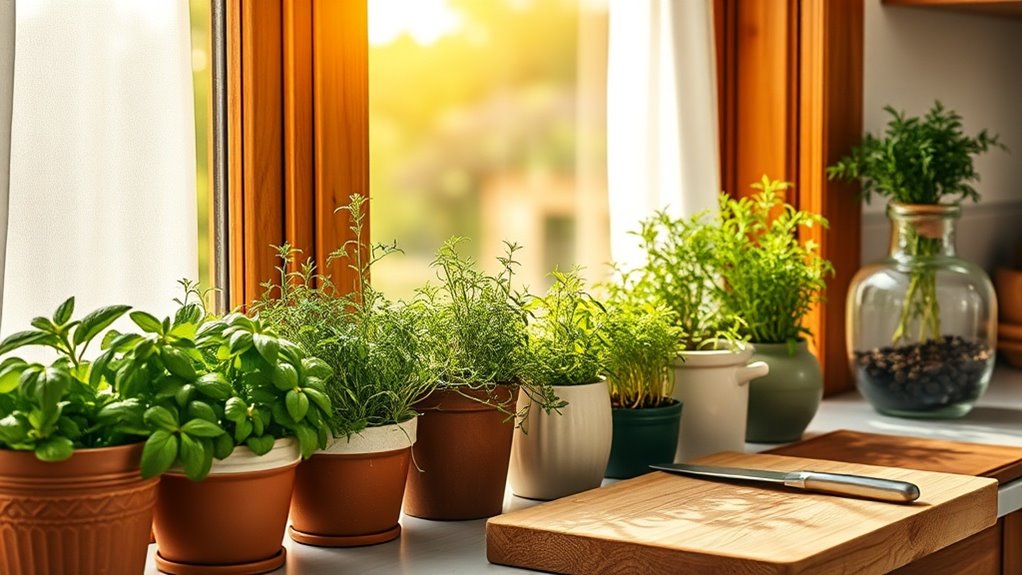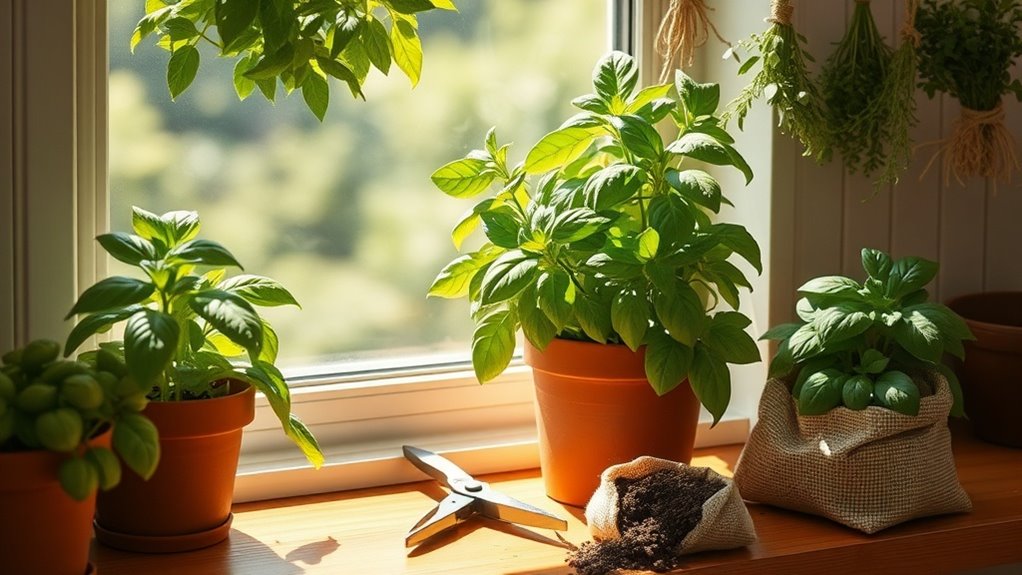How I Doubled My Basil Harvest With This Easy Trick
To double your basil harvest, focus on strategic pruning. Regularly pinch off the tops of your plants to encourage bushier growth and prevent early flowering. Make sure your basil gets 6-8 hours of sunlight daily, and maintain well-drained, fertile soil with consistent moisture. Additionally, fertilize every four to six weeks for ideal nutrient levels. This combination boosts overall health and productivity. Stick around to uncover further secrets for maximizing your basil plant’s potential!
Understanding Basil Growth Habits
How can you maximize your basil harvest by understanding its growth habits?
In herb gardening, basil thrives in warm conditions with plenty of sunlight—ideally six to eight hours daily.
Monitor soil moisture, aiming for consistent, well-drained soil; overwatering can lead to root rot.
You’ll notice basil grows best when pinched back regularly, promoting bushier plants.
Additionally, be aware of its growth cycle: basil can bolt in hot weather, shifting energy to flowering instead of leaf production. Pairing basil with tomatoes can also improve pest resistance and overall plant health in your garden.
The Importance of Pruning
Pruning is essential for maximizing your basil harvest, as it encourages healthy growth and increases leaf production. By regularly removing the top leaves and flowering stems, you redirect the plant’s energy towards producing more foliage rather than seeds. This practice not only enhances the flavor but also extends the growing season. Additionally, implementing specific pruning habits can transform your gardening experience and lead to healthier, more abundant plants.
| Pruning Technique | Benefits |
|---|---|
| Pinching Off Tops | Increases bushiness |
| Removing Flowers | Prevents energy diversion |
| Cutting Above Nodes | Stimulates new growth |
| Regular Trimming | Maintains plant health |
| Seasonal Pruning | Adapts to growth cycles |
Incorporate these techniques for best results!
Timing Your Harvest
When’s the best time to harvest your basil for maximum flavor and yield?
Timing is essential.
For best results, consider these tips:
- Morning Harvest: Pick your basil in the morning when oils are most concentrated, resulting in enhanced flavor.
- Before Flowering: Harvest before the plant flowers, as this can lead to bitterness.
- Regular Trimming: Regularly trim leaves to encourage bushier growth, providing more harvest opportunities.
Additionally, understanding optimal planting times can further enhance the flavor profile of your basil throughout the growing season.
Optimal Growing Conditions
To maximize your basil harvest, you need to understand its ideal growing conditions. Basil thrives in full sunlight, so ensuring it receives at least 6 to 8 hours of direct light each day is essential. Additionally, focusing on soil quality and implementing effective watering techniques will set the foundation for robust plant growth. Incorporating low-maintenance herb gardening practices can further enhance your success in cultivating basil.
Light Requirements for Basil
How much light does basil really need to thrive?
Basil requires 6 to 8 hours of direct sunlight daily to grow ideally.
Without adequate light, your plants may become leggy and sparse.
Here are some key factors to take into account:
- Sunlight Type: Use full-spectrum light for indoor growing, mimicking natural sunlight.
- Light Intensity: Position your basil near south-facing windows or use grow lights for consistent brightness.
- Seasonal Adjustments: Be mindful of seasonal changes; you may need to adjust light exposure as days shorten or lengthen.
Soil Quality Essentials
The right soil quality is essential for basil’s growth and overall health.
Start with well-draining, loamy soil rich in organic matter, ideally with a pH between 6.0 and 7.0.
Incorporate compost or aged manure to boost nutrients and improve soil structure.
Make sure the soil retains moisture without becoming waterlogged; basil roots thrive in aerated conditions.
Regularly test your soil for nutrient levels, particularly nitrogen, phosphorus, and potassium, to maintain ideal fertility.
Amend with organic fertilizers as needed.
Watering Techniques Explained
When should you water your basil to achieve best growth?
Timing and technique are essential.
Water your basil in the early morning or late afternoon to minimize evaporation.
Aim for deep, thorough watering rather than frequent light sprinkles.
Here are some tips to optimize your watering routine:
- Consistent Schedule: Water once a week, adjusting for weather conditions.
- Soil Check: Stick your finger into the soil; if it’s dry an inch down, it’s time to water.
- Avoid Overwatering: Provide drainage to prevent root rot, as basil prefers well-aerated soil.
These practices will help maximize your basil harvest.
The Secret Technique Revealed
To maximize your basil harvest, you need to master key techniques such as precise pruning, effective watering, and ideal sunlight exposure. Pruning encourages bushier growth, while proper watering guarantees the plant remains healthy and productive. Additionally, understanding the sunlight requirements will help you position your basil for maximum photosynthesis and yield. Furthermore, incorporating one extraordinary herb into your gardening routine can unlock new levels of success.
Pruning for Growth
Pruning basil isn’t just a chore; it’s an essential technique that greatly boosts growth and flavor.
By trimming your plants strategically, you encourage bushier growth and prevent them from becoming leggy.
Here are three key tips for effective pruning:
- Cut just above a leaf node: This encourages new growth from that point.
- Remove flowering stems: Flowers can divert energy from leaf production, reducing your harvest.
- Prune regularly: Aim for every 4-6 weeks during the growing season to maintain ideal health.
Implementing these techniques will enhance your basil’s vitality and ultimately lead to a more abundant harvest.
Optimal Watering Techniques
Watering basil properly is essential for maximizing your harvest. Aim to keep the soil consistently moist but not soggy.
Water deeply once or twice a week, depending on your climate and soil type. You can check moisture levels by inserting your finger about an inch into the soil; if it feels dry, it’s time to water.
Consider using drip irrigation for efficiency, ensuring water reaches the roots without wetting the foliage. Early morning is the best time to water, reducing evaporation and fungal diseases.
This technique encourages strong root development and enhances flavor, leading to a bountiful basil yield.
Sunlight Exposure Tips
How can you guarantee your basil plants receive the ideal sunlight they crave for best growth?
To maximize your harvest, focus on these key sunlight exposure tips:
- Location: Place your basil in a south-facing window or outdoors where it can bask in at least 6-8 hours of direct sunlight daily.
- Rotation: Regularly rotate your pots to guarantee even exposure, preventing uneven growth and leggy plants.
- Shade Management: If it’s too hot, provide some afternoon shade to protect your basil from scorching, helping maintain healthy foliage.
Maintaining Your Basil Plant for Future Harvests
What steps can you take to guarantee your basil plant thrives for future harvests?
First, regularly prune your basil to encourage bushier growth and prevent flowering, which can diminish flavor.
Water consistently, ensuring the soil drains well; overwatering can lead to root rot.
Fertilize every four to six weeks with a balanced, water-soluble fertilizer to replenish nutrients.
Monitor for pests like aphids or spider mites and treat them promptly with insecticidal soap if necessary.
Finally, maintain a warm environment, ideally between 70-90°F (21-32°C), to promote healthy growth. Additionally, consider planting flavorful herbs alongside your basil to create a diverse and productive container garden.

